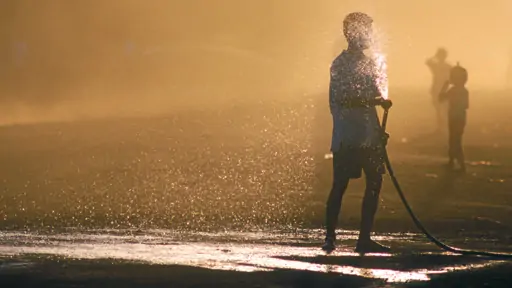Indigenous Calendar June, 2014: The Road to Ban Lung, Cambodia

Photographs that 'work' might do so for many reasons: the image might be subliminally evocative; the photographic technique might produce something visually stunning; a scene captured from an historic event might remind the viewer of something profound about their own life experiences. This photograph is not one of those.
I was in northeastern Cambodia many years ago. Ban Lung is the main town there in Ratakaniri Province. I'd arrived by small plane — which back then was the only way to arrive there unless you were prepared to spend many hours traveling by dirt road from the Vietnamese border (at the time it was only open to Vietnamese and Cambodian citizens) or to spend many more hours traveling by passenger boat along the Mekong River and then transfer to whatever form of transportation might be available that day... or the next... or the next.
Today there are no passenger boats along the Mekong River in Cambodia. Nor does that plane fly any longer; the airport is deserted and the landing strip is overgrown with grass and weed.
Photographers often know instinctively that there are some photographs that can never be taken again. When they see them they point their camera, frame, focus, expose and click. This photograph is one of those.
Until a few years ago this was a typical scene every evening in Ban Lung. After hosing down the dirt road at sunset in a fruitless attempt to clear the air of the day's dust, this man hoses himself down in a similarly fruitless attempt to cleanse himself of that same dust. Today there are no dirt roads in Ban Lung — at least not in the core downtown area.
There were always three major dirt roads into Ban Lung. Today the one running south to Sen Monorom in Mondulkiri Province is the only one not yet (but soon to be) graded and paved. Travelers to and from the Vietnamese border now take a journey in one hour that used to last five.
Most of us would probably call this progress and assume it could only benefit the Cambodian people. We would be very wrong. For along that road live mainly indigenous people — particularly the Tampuan, Kreung and Kachok. They have had little contact with the outside world until now. Along with their traditional lands, their traditional livelihoods are also being taken away from them. The area is rich in semiprecious gemstones that have always been mined by hand and sold at low cost. Today this same industry is a major part of the region's commerce. In fact it is so lucrative that it is now controlled mainly by the Vietnamese and the Chinese. Labor migration among these indigenous peoples is on the rise in a scenario that predates their formal education. Accounts are surfacing that the road is becoming a route for human traffickers.
Some might say that dirt and dust have been replaced by things that are harder to photograph — greed and corruption.
The Tampuan, Kreung and Kachok are featured in our documentary, Indigenous Peoples of Southeast Asia.
If you enjoyed reading this article, please consider supporting independent, advertising-free journalism by buying us a coffee to help us cover the cost of hosting our web site. Please click on the link or scan the QR code. Thanks!


